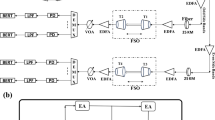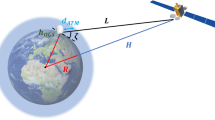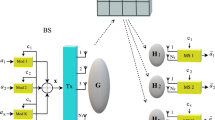Abstract
Free space optics (FSO) is a capable key which offers high data rate, more secure and cost effective system to other conventional communication systems. Although it is a first and last mile preference to other setups but still lags in a variety of scenarios. The main limitation of FSO is seen in worse weather conditions where it suffers highest attenuation in transmitted signal. The weather which affects the transmission most are rain and haze due to which the received signal fades away and the signal to noise ratio diminishes which violates the characteristics of an ideal FSO link system. In this paper, wavelength division multiplexing (WDM) is used to enhance the signal power with the use of optical amplifiers so that a better signal could be obtained at the receiver. A WDM-FSO system using hybrid configurations of optical amplifiers is proposed which provides a promising solution for low cost and highly efficient systems.









Similar content being viewed by others
References
Malik, A., & Singh, P. (2014). Comparative analysis of point to point FSO system under clear and haze weather conditions. Wireless personal communications, 80, 483–492.
Kim, I. I., McArthur, B., & Korevaar E. J. (2001). Comparison of laser beam propagation at 785 nm and 1550 nm in fog and haze for optical wireless communications. In SPIE (Vol. 4214).
Malik, A., & Singh, P. (2015). Free space optics: Current applications and future challenges. International Journal of Optics, 2015, 1–7.
Carneiro, V. G. A., Rodrigues, G. K., & Giraldi, M. T. M. R. (2012). Performance analysis of a 2D double hard-limited OCDMA system over FSO link under strong turbulence for defense applications. (pp. 1–6). IEEE.
Hatziefremidis, A., Zarganis, K. E., Leligou, H. C., & Pleros, N. (2014). Bit error rate analysis along a slanted path link between UAVs and ground stations. In ICTON (pp. 1–4). IEEE.
Gregory, M., & Badri-Hoeher, S. (2011). Characterization of maritime RF/FSO channel. In 2011 International Conference on Space Optical Systems and Applications (pp. 21–27). IEEE.
Muhammad, S. S., Plank, T.,Leitgeb, E., Friedl, A., Zettl, A., Javornik, T., & Schmitt, N. (2008). Challenges in establishing free space optical communications between flying vehicles. (pp. 82–86). Graz: IEEE.
Dayal, N., Singh, P., & Kaur, P. (2015). Performance enhancement in WDM-FSO system using optical amplifiers under different rain conditions. In ICICCD. Springer.
Kshatriya, A. J., Acharya, Y. B., & Aggarwal, A. (2013). Analysis of free space optical link in Ahmedabad weather conditions. In Proceedings of 2013 IEEE Conference on Information and Communication Technologies.
Ismail, K., Menon, P. S., Bakarman, H. A., Bakar, A. A. A., & Arsad, N. (2012). Performance of 18 channel CWDM system with inline semiconductor optical amplifier. In 3rd International Conference on Photonics (pp. 1–3).
Bobrovs, V., Olonkins, S., Ozolins, O., Porins, J., & Lauks, G. (2012). Hybrid optical amplifiers for flexible development in long reach optical access system. In 3rd Fiber Optics in Access Network—FOAN (pp. 577–582).
Wu, H., & Kavehrad, M. (2007). Availability evaluation of ground to air hybrid FSO/RF links. International Journal of Wireless Information Networks, 14(1), 33–45.
Nadeem, F., Leitgeb, E., Awan, M. S., & Chessa, S. (2009). Comparing lifetime of terrestrial wireless sensor network by hybrid FSO/RF and only RF. In 2009 Fifth International Conference on Wireless and Mobile Communication. IEEE.
Nadeem, F., & Leitgeb, G. (2010). Dense maritime fog attenuation prediction from measured visibility data. Radio Engineering, 19(2), 223–227.
Shah, D., & Kothari, D. K. (2014). Optimization of 2.5 Gbps WDM-FSO link range under different rain conditions in Ahmedabad. In 2014 Annual IEEE India Conference (INDICON).
Fadhil, H. A., Amphawan, A., Shamsuddin, H. A. B., Abd, T. H., Al-Khafaji, H. M. R., Aljunid, S. A., et al. (2013). Optimization of free space optics parameters: An optimum solution for bad weather conditions. Optik-International Journal for Light and Electron Optics, 124(19), 3969–3973.
Jain, P., Vashist, K., & Gupta, N. (2014). Comparison study of hybrid optical amplifier. International Journal of Scientific Research Engineering and Technology, 3(9), 1289–1292.
Author information
Authors and Affiliations
Corresponding author
Rights and permissions
About this article
Cite this article
Dayal, N., Singh, P. & Kaur, P. Long Range Cost-Effective WDM-FSO System Using Hybrid Optical Amplifiers. Wireless Pers Commun 97, 6055–6067 (2017). https://doi.org/10.1007/s11277-017-4826-7
Published:
Issue Date:
DOI: https://doi.org/10.1007/s11277-017-4826-7




